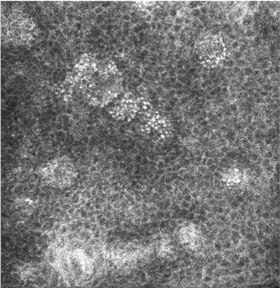Stratum spinosum
The stratum spinosum (also known as the prickly cell layer ) is a layer of the upper skin (epidermis) that is located above the basal layer (stratum basale) and below the granular layer (stratum granulosum). The name prickly cell layer comes from the fact that the cells shrink during histological processing and then take on a prickly appearance in the preparation.
In the stratum spinosum , the cells are connected to desmosomes by cytoplasmic extensions . This is where the step-by-step cornification process known as keratinization begins . Stratum basale and stratum spinosum are collectively referred to as stratum germinativum (synonym: germ layer, regeneration layer); Cell division takes place in the germinal layer.
The stratum spinosum also contains defense cells of the lymphatic system , which are known as Langerhans cells : After phagocytosis of foreign material, they present the antigens on their surface and migrate to the nearby lymph nodes ; It is assumed that the Langerin protein formed by the Langerhans cells forms a barrier against the penetration of human immunodeficiency viruses (HIV).
Individual evidence
- ↑ Anatomy of the Skin (www.utmb.edu, accessed September 9, 2016)
- ↑ Stratum spinosum (flexikon.doccheck.com, accessed on September 9, 2016)
- ↑ Upper skin (epidermis) ( Memento of the original from September 13, 2016 in the Internet Archive ) Info: The archive link was inserted automatically and has not yet been checked. Please check the original and archive link according to the instructions and then remove this notice. (www.medizin-kompakt.de, accessed on September 9, 2016)
- ↑ Thumbnail overview of Langerhans cells (www.uni-mainz.de, accessed on September 9, 2016)
- ↑ Langerin is a natural barrier to HIV-1 transmission by Langerhans cells (abstract of the article on www.nature.com from March 4, 2007)


